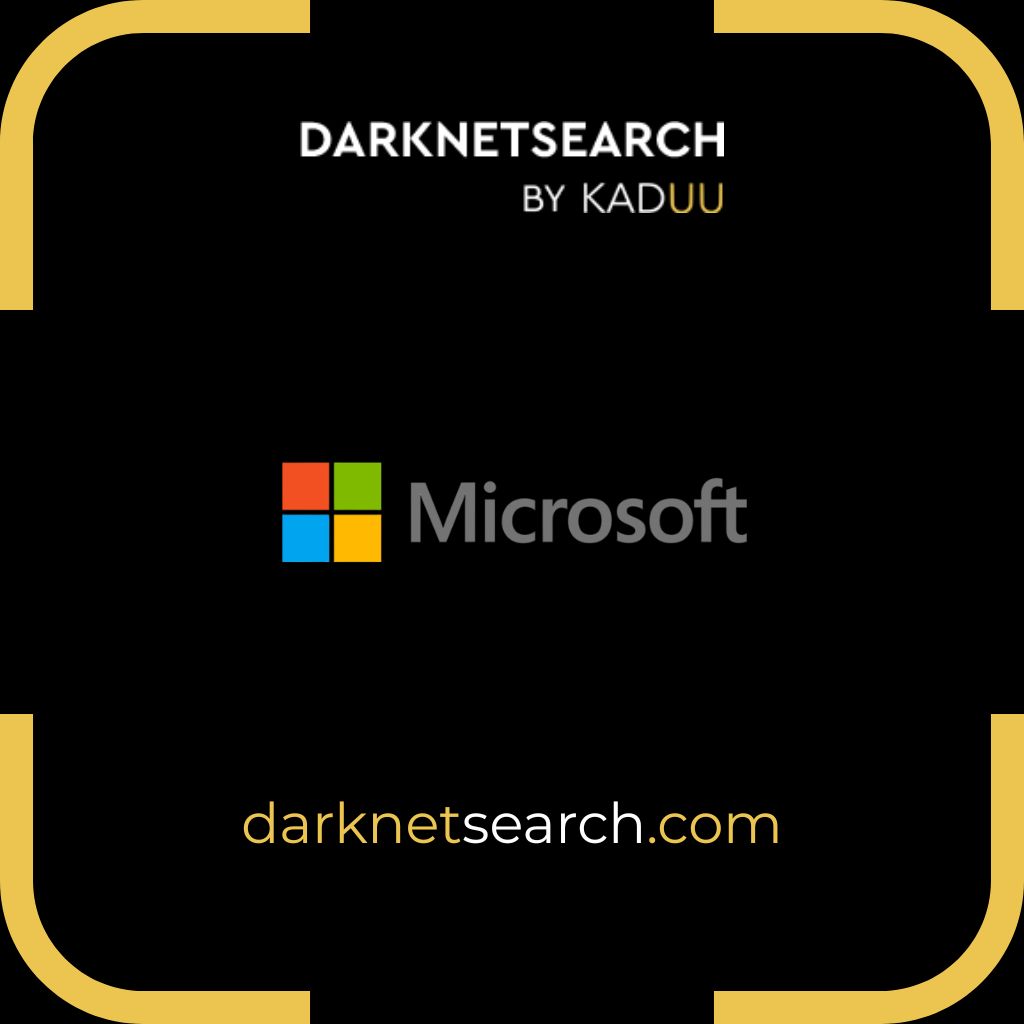➤Summary
The Microsoft outage that struck on October 29, 2025 sent shockwaves 🌍 through the global digital ecosystem. This wasn’t just a small glitch — it was a massive Azure outage affecting Microsoft 365, Xbox Live, Minecraft, and several enterprise platforms worldwide. The Microsoft outage affecting Xbox and Minecraft services highlighted how deeply the modern web depends on Microsoft’s cloud. From gamers 🎮 to global businesses, millions felt the impact.
Interestingly, the Kaduu Team, while monitoring dark-web and deep-web forums, first detected chatter about disruptions — once again proving why darknetsearch.com is essential for early detection, cyber threat intelligence, and incident response.
What Exactly Happened During This Azure Outage?
The Microsoft outage began around 16:00 UTC when users reported errors accessing the Azure Portal and cloud-based apps. According to The Verge, Microsoft later confirmed a configuration bug in Azure Front Door, its global routing and CDN system that handles web traffic for nearly every Microsoft service.
As the outage spread, Azure, Microsoft 365, Xbox Live, and Minecraft servers began failing simultaneously. Even external clients such as Starbucks, Costco, and Air New Zealand saw downtime because their services rely heavily on Azure infrastructure. Microsoft engineers initiated an emergency rollback and traffic rerouting.
From a cybersecurity standpoint, the incident also raised questions about the CIA Triad — Confidentiality, Integrity, and Availability — the three pillars of information security. While no data breaches occurred, the availability aspect of the CIA Triad was clearly compromised, reminding businesses how critical redundancy and uptime resilience are in cloud-dependent ecosystems.
By late evening UTC, the company reported 98 percent recovery, as noted by AP News.
Which Services Were Impacted in the Microsoft Outage?
| Platform / Service | Impact | Status |
| Azure Core & Portal | Unavailable across regions; high latency | ✅ Recovered |
| Microsoft 365 Suite | Teams, Outlook, and OneDrive down | ✅ Restored |
| Xbox Live | Sign-in and multiplayer issues | ✅ Restored |
| Minecraft Online | Authentication and login failures | ✅ Restored |
| Retail & Airlines | Starbucks App and Alaska Airlines systems down | ✅ Recovered |
This Azure outage disrupted productivity, retail, travel, and entertainment, proving how one small configuration error can ripple across the globe. 😬
Why Did This Happen — and Why It Matters 💡
The root cause was an inadvertent configuration change within Azure Front Door (AFD) — Microsoft’s central traffic router. Wired reports that this single mis-step triggered cascading DNS and routing failures that made core services unreachable.
Key Factors:
- Configuration Error: One faulty deployment script took down global routing.
- Cascading Impact: Since most Microsoft services rely on AFD, downstream failures multiplied.
- Infrastructure Centrality: Azure powers both Microsoft and thousands of enterprise clients.
- Industry Context: This Microsoft outage came just days after an AWS incident — underlining shared vulnerabilities in hyperscale clouds.
As one cybersecurity analyst put it, “When your DNS layer fails, everything above it collapses — even if you’re Microsoft.”
Hidden Angle: Kaduu Team’s Early Detection via the Dark Web 🕵️♂️
While social media buzzed with speculation, the Kaduu Team identified early signals of the outage through underground discussions on dark-web and deep-web forums. Mentions of “Azure Front Door” and “routing misconfigurations” surfaced hours before Microsoft’s official acknowledgment — highlighting how dark-web monitoring has become a crucial layer of modern cybersecurity.
🔎 Why Dark-Web Monitoring Matters
- Early Warning: Threat actors or insiders may leak internal data or configuration chatter before official disclosure.
- External Visibility: Even if your systems are fine, your cloud provider’s outage can affect you — and dark-web chatter often reveals it first.
- Risk Detection: Monitoring platforms like darknetsearch.com help identify compromised credentials, leaked configs, or emerging vulnerabilities.
- Faster Response: Early alerts let organizations adjust before business-critical impact hits.
Practical Tip ✅:
- Track mentions of your domains or infrastructure via darknetsearch.com.
- Combine internal dashboards with external signals to strengthen awareness and response time.
Lessons Learned from the Microsoft Outage 🌐
- Single Points of Failure Exist. Even the largest providers can fail catastrophically.
- Adopt Multi-Cloud Strategies. Don’t rely on one vendor; diversify workloads.
- Transparency Builds Trust. Microsoft’s timely updates were helpful, but third-party verification adds credibility.
- User Preparedness Matters. Save backups and know official status channels.
- Dark-Web Intelligence Complements Monitoring. It’s essential for proactive risk management.
How to Prepare for the Next Azure Outage ⚙️
For Businesses:
- Audit all Azure dependencies (especially Azure Front Door).
- Maintain hybrid or multi-cloud failover systems.
- Integrate dark-web intelligence from darknetsearch.com into your monitoring stack.
- Conduct quarterly disaster-recovery drills.
For Users:
- Follow the official Azure Status Page before troubleshooting locally.
- Back up essential files from Microsoft 365 to local storage.
- Remember that service-wide Microsoft outages are global, not personal device issues.
Expert Insight 💬
According to cyber-risk assessment analyst Laura Kim,
“This Microsoft outage affecting Xbox and Minecraft services proves our cloud dependency is far ahead of our resilience. The edge belongs to those who can see trouble before others — and that’s where dark-web monitoring shines.”
Quick Cloud-Resilience Checklist 📋
| Category | What to Do | Resource |
| Monitoring | Track outages & dark-web chatter | darknetsearch.com |
| Backup | Use multi-region replication | Azure Geo-Redundant Storage |
| Communication | Prepare alternate channels | Slack / Zoom |
| Testing | Run quarterly failover drills | IT Resilience Audit |
| Security | Scan for leaked credentials | darknetsearch.com |
Final Thoughts & Next Steps 🚀
The Microsoft outage was more than downtime — it was a clear reminder of how fragile global cloud infrastructure can be. Businesses and individuals must combine resilience planning with intelligence visibility to stay ahead of disruptions. By leveraging platforms like darknetsearch.com, you gain that extra edge to detect early risks, anticipate threats, and safeguard uptime.
🎯 Discover much more in our complete guide
💼 Request a demo NOW
Your data might already be exposed. Most companies find out too late. Let ’s change that. Trusted by 100+ security teams.
🚀Ask for a demo NOW →Q: What is dark web monitoring?
A: Dark web monitoring is the process of tracking your organization’s data on hidden networks to detect leaked or stolen information such as passwords, credentials, or sensitive files shared by cybercriminals.
Q: How does dark web monitoring work?
A: Dark web monitoring works by scanning hidden sites and forums in real time to detect mentions of your data, credentials, or company information before cybercriminals can exploit them.
Q: Why use dark web monitoring?
A: Because it alerts you early when your data appears on the dark web, helping prevent breaches, fraud, and reputational damage before they escalate.
Q: Who needs dark web monitoring services?
A: MSSP and any organization that handles sensitive data, valuable assets, or customer information from small businesses to large enterprises benefits from dark web monitoring.
Q: What does it mean if your information is on the dark web?
A: It means your personal or company data has been exposed or stolen and could be used for fraud, identity theft, or unauthorized access immediate action is needed to protect yourselfsssss.

